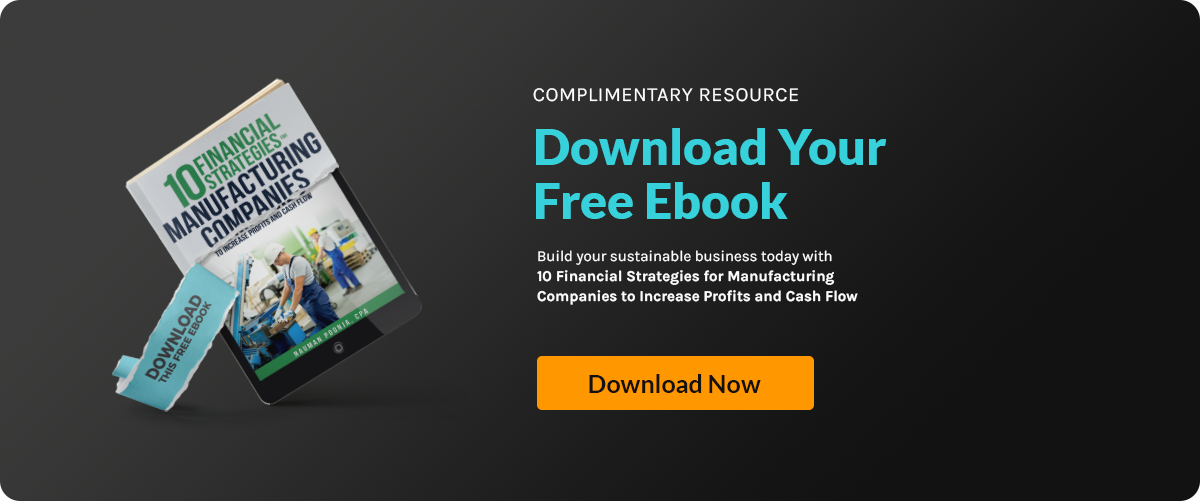Production is moving, and orders are steady, but when it’s time to pay suppliers or invest in new...
Why Strategic Financial Planning Matters in Manufacturing

A manufacturing business can be running at full capacity yet still struggle financially. Orders are coming in, and production is steady, but without a clear financial plan, unexpected costs or slow cash flow can create serious setbacks. Growth isn’t just about increasing output—it’s about making sure the numbers support it.
Many manufacturers operate month to month, focusing on immediate expenses without a long-term strategy. But without a plan, it’s easy to miss opportunities or run into financial roadblocks. Research even says businesses that take the time to map out a strategic financial plan grow up to 30% faster than those that don’t.
A well-structured financial plan isn’t just about budgeting—it’s about preparing for the future. From improving profitability to staying ahead of market shifts, here’s how strategic financial planning keeps manufacturing businesses stable and ready for what’s next.
Strategic Financial Planning in Manufacturing
Let’s say a manufacturer is doing well, getting more orders and expanding operations. But without a clear financial roadmap, expenses rise, payments get delayed, and production slows down. What started as a period of growth quickly turned into a struggle to keep things running. This is just an example, but many businesses face the same challenges when they don’t plan ahead.
A strong cash flow plan helps avoid these issues by keeping track of income and expenses. KPI monitoring and reporting allow manufacturers to measure performance, spot inefficiencies, and make adjustments before small problems become bigger ones. Planning ensures better resource allocation, prevents unnecessary spending, and supports long-term success.
A well-structured financial roadmap keeps businesses stable. The next step is building a cash flow plan that ensures manufacturers stay ahead of expenses and keep operations running without disruption.
Building a Cash Flow Plan for Stable Operations
Manufacturers can’t afford uncertainty when it comes to funding daily operations. A cash flow plan ensures that income and expenses are predictable, keeping production and payments on schedule. Without one, businesses risk running short on funds, delaying orders, or cutting costs in the wrong places.
To build a strong plan, manufacturers should focus on these key elements:
✔ Cash Reserves – Set aside emergency funds to cover unexpected costs.
✔ Predictable Payment Schedules – Align supplier and customer payments to maintain stability.
✔ Expense Tracking – Monitor spending to avoid unnecessary costs and keep operations lean.
✔ Revenue and Expense Planning – Forecast future earnings and adjust spending accordingly.
✔ KPI Monitoring and Reporting – Track key performance indicators to identify issues before they escalate.
✔ Financial Roadmap Alignment – Connect short-term cash needs to long-term growth goals.
A clear cash flow plan reduces uncertainty and keeps manufacturers in control of their operations. When paired with a strong financial roadmap, businesses can stay ahead of challenges and focus on growth.
Accurate KPI Monitoring and Reporting for Smarter Financial Decisions
Manufacturers rely on accurate data to stay competitive. Without proper KPI monitoring and reporting, inefficiencies go unnoticed, leading to lower profits and poor planning. Tracking the right metrics ensures that businesses follow a strong financial roadmap and adjust operations as needed.
Here are the KPIs that manufacturers should monitor:
- Cash Flow Ratio
This measures how well a company can cover short-term expenses. A strong ratio ensures the cash flow plan stays stable and prevents sudden disruptions. - Working Capital Turnover
This tracks how efficiently a business uses its assets to generate revenue. A high turnover means resources are being used effectively, while a low turnover may indicate inefficiencies. - Profit Margin
This shows how much profit is earned from sales. Monitoring margins helps businesses adjust pricing strategies and reduce unnecessary costs to maximize revenue. - Operating Expense Ratio
This compares operating costs to total revenue. A lower ratio means better cost management, while a rising ratio signals the need for expense control. - Return on Assets (ROA)
This measures how well a company turns investments into profits. A higher ROA suggests strong asset management and efficient resource allocation. - Inventory Turnover
This tracks how quickly inventory is sold and replaced. A slow turnover may signal excess stock or weak demand, affecting overall efficiency. - Debt-to-Equity Ratio
This compares the total debt to shareholder equity. A high ratio suggests over-reliance on debt, which can create financial strain and limit future growth. - KPI Monitoring and Reporting Accuracy
This ensures real-time data is collected and analyzed. Businesses that rely on outdated reports struggle to make informed decisions.
Why KPI Tracking Improves Decision-Making
Effective KPI monitoring and reporting keep manufacturers focused on key performance areas. When combined with a clear cash flow plan and financial roadmap, businesses gain better control over spending, pricing, and resource allocation. Regular tracking ensures that companies stay on course and adapt to changing market conditions.
Creating a Financial Roadmap for Business Growth
Running a manufacturing business without a financial roadmap is like navigating without a map. A company might start strong, but without clear direction, expenses pile up, production slows, and profit margins shrink. Raw materials get more expensive, customers take longer to pay, and soon, there's no room to invest in new equipment or expansion.
Here are the steps to creating a structured plan that helps manufacturers stay in control:
Step 1: Identify Business Goals That Align with Operations
A manufacturer planning to expand production needs more than just increased sales. They need to account for higher material costs, additional labor, and potential supply chain disruptions. Clear short-term and long-term goals guide resource allocation and prevent overspending.
Pro Tip: Set goals that match operational capacity. Scaling too fast without adjusting expenses can lead to financial strain.
Step 2: Assess Current Financial Position and Cash Flow Cycles
Reviewing manufacturing financial statements helps identify cash shortages and delayed receivables. If suppliers demand payment upfront but customers take 60 days to pay, working capital takes a hit. Understanding these cycles prevents sudden shortages.
Pro Tip: Check payment terms with suppliers and customers. If receivables take too long, negotiate better terms or offer early payment incentives.
Step 3: Create a Budget That Reflects Production Realities
A budget isn’t just numbers—it should match actual manufacturing conditions. If machine downtime is frequent, maintenance costs should be planned. If material prices fluctuate, buffer funds should be set aside. A realistic budget avoids production delays and unexpected financial gaps.
Pro Tip: Factor in seasonal demand changes. Slower months still require payroll, utilities, and fixed costs.
Step 4: Set KPIs That Show Production and Profitability Trends
Tracking the wrong KPIs leads to blind spots. KPI monitoring and reporting should include production efficiency, cost per unit, and operating margin. If the cost per unit rises but sales stay the same, profitability shrinks. Monitoring these trends helps businesses act before margins disappear.
Pro Tip: Track working capital turnover. If capital is tied up in unsold inventory, cash shortages will follow.
Step 5: Adapt the Roadmap to Changing Market Conditions
Supply chain disruptions, economic downturns, or rising material costs force businesses to pivot. A rigid plan fails when market conditions shift. Reviewing the financial roadmap quarterly allows adjustments based on performance and external factors.
Pro Tip: Have alternative suppliers lined up. Relying on a single vendor increases vulnerability to price hikes and shortages.
A strong strategic financial planning process gives manufacturers control over their future. With a clear cash flow plan and effective KPI monitoring and reporting, businesses can navigate challenges, reduce inefficiencies, and invest in long-term stability.
Build a Financial Plan That Works
Manufacturing finances can be unpredictable. One month, cash flow is steady; the next, unexpected costs throw everything off. Without a solid financial plan, it’s hard to stay ahead and make confident decisions.
At Accounovation, we help manufacturers take control of their finances with customized planning. We analyze cash flow, identify risks, and create strategies for budgeting, forecasting, and long-term growth. Our expert guidance helps you stay prepared, make informed decisions, and keep your business moving forward. Contact us, and let’s build a plan that works for you.







